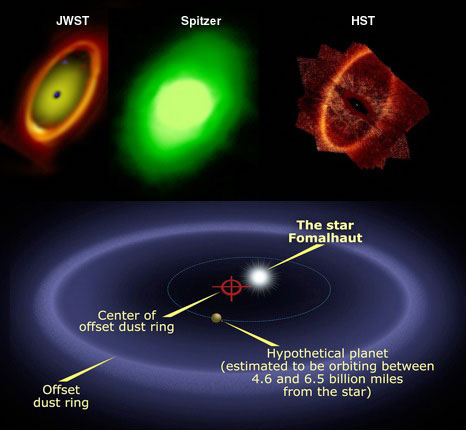James Webb Space Telescope Special Exhibit
Planetary Systems and the Origins of Life

JWST, Spitzer and HST views of the area around the star Fomalhaut, with diagram showing a suspected planet. (Credit: NASA)
The first planet outside our solar system was discovered in 1995. Since then, we have discovered a multitude of planets around other stars. We have come to the realization that planets appear to be quite common. Most of the planets discovered so far are large gas giants like Jupiter, although modern detection techniques are now helping scientists detect smaller planets. The ultimate objective of the search is to find another Earth and perhaps even signs of life elsewhere in the universe.
To trace how planets like the Earth form and how life might arise on such planets, scientists need to study planet formation and evolution, including the material around stars where planets form. A key issue is to understand how the building blocks of planets are assembled. Scientists do not know if all planets in a planetary system form in place or travel inwards after forming in the outer reaches of the system. It is also not known how planets reach their ultimate orbits, or how large planets affect the smaller ones in solar systems like our own.

Illustration of a Jupiter-sized planet orbiting a sun-like star. (Credit: NASA/ESA/STSci/G. Bacon)
The icy bodies and dust in the outer reaches of our solar system are evidence of conditions when our solar system was very young. Scientists can directly compare those conditions to the objects and dust observed around other stars. The sensitive instruments on Webb will be able to obtain infrared images of giant planets and planetary systems and characterize their ages and masses by measuring their spectra. Webb will also be able to measure spectra of the disks around other stars to determine the properties of such disks that give rise to planetary systems.
In addition to studying planets outside our solar system, scientists want to learn more about our own home. Studying the chemical and physical history of the small and large bodies that came together to form the Earth may help us discover how life developed on Earth. Webb will be powerful enough to identify and characterize comets and other icy bodies in the outermost reaches of our solar system, which might contain clues to our origins on Earth.
Published: April 2007
Text Reviewed: September 2018


